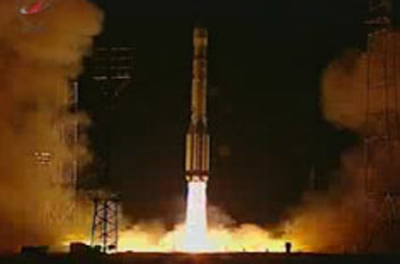Russia Launches 3 New Navigation Satellites

Three more Glonass navigationsatellites were dispatched to space Monday, ensuring the network continuesproviding positioning services to Russian territory as officials seek to expandit to global coverage.
The Glonassconstellation is Russia's counterpart to the U.S. Global Positioning System. Glonass satellitesprovide users with navigation coordinates, velocity and precise timing information.
The replenishment satellitesblasted off aboard a Proton rocket at 2119 GMT (4:19 p.m. EST) from theBaikonur Cosmodrome in Kazakhstan. The Proton blazed a dazzling trail into thesky above Baikonur, where it was just after midnight local time.
The first stage's six mainengines gave way to the Proton's second stage about two minutes after liftoff.The Proton flew out of sight of ground tracking cameras about six minutes intothe mission.
Within the first 10 minutes ofthe flight, the rocket was supposed to release the Glonass payloads and theBlock DM upper stage in space.
The Block DM is expected to fireits main engine twice to push the Glonass satellites into a circular orbit12,000 miles high with an inclination of about 64.8 degrees.
The upper stage will release itsgrasp on the Glonass spacecraft before 0100 GMT Tuesday (8 p.m. EST Monday).
Breaking space news, the latest updates on rocket launches, skywatching events and more!
Each satellite weighs about 3,000pounds at launch, including maneuvering fuel to maintan the craft's orientationin space. The modernized Glonass M spacecraft are designed to operate for sevenyears in orbit, according to their manufacturer, Information Satellite SystemsReshetnev Co.
Glonass satellites broadcastnavigation signals to military and civilian users from their orbital perch,reaching ground receivers across a swath of Earth nearly stretching from poleto pole.
According to a Russian SpaceAgency Web site, there are 18 operational satellites in the fleet as of March1. Two more satellites are out of commission for maintenance.
The constellation is spread amongthree orbital planes, each designed to contain eight satellites to maximizeglobal navigation coverage. The satellites launched Monday are headed for PlaneNo. 3, according to the Russian Space Agency.
Global service requires 24healthy Glonasssatellites, while complete coverage of Russian territory demands 18operational spacecraft.
Three Glonass platforms weredelivered to orbit during another Proton launch last Dec. 14, and another triois scheduled for launch in August, Russian space officials said.
Monday's mission was the thirdProton flight of the year. Between 12 and 14 Proton launches are on the booksfor 2010, including commercial and government missions.
The next Proton launch isscheduled for March 20 with the EchoStar 14 direct broadcasting satellite forthe United States.
- Images- 20 Great Rocket Launches
- Video- NASA?s Constellation Program Cancelled
- Video- Dramatic Night Launch of a Space Shuttle
Copyright 2009 SpaceflightNow.com,all rights reserved.
Stephen Clark is the Editor of Spaceflight Now, a web-based publication dedicated to covering rocket launches, human spaceflight and exploration. He joined the Spaceflight Now team in 2009 and previously wrote as a senior reporter with the Daily Texan. You can follow Stephen's latest project at SpaceflightNow.com and on Twitter.

